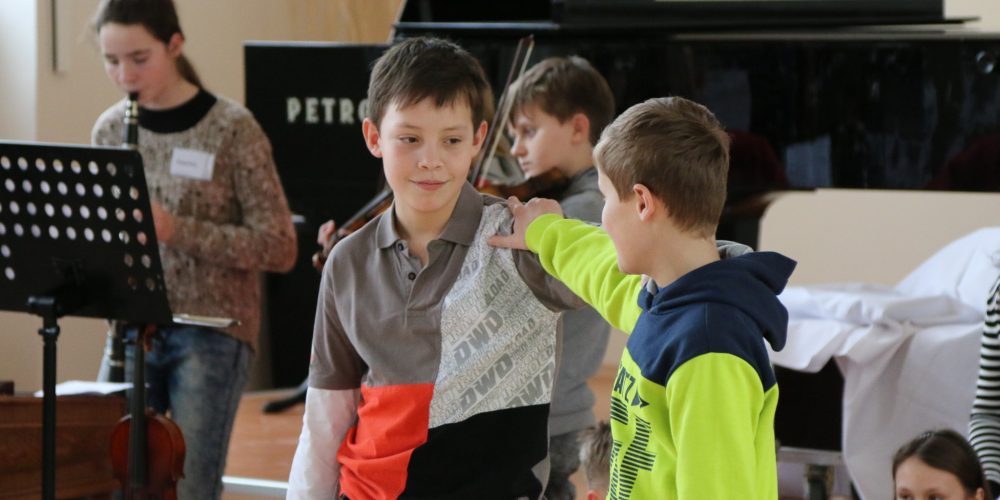One of the basic ideas of the Musik kreativ+ Programme, supporting the creativity in school music lessons, is the use of cooperation between university departments, elementary schools and professional music ensembles (see the project description). The heterogeneous structure of the project, given by the diversity of the partners and individual programmes within four European countries, offers the chances of application in the space of national and multinational units on the basis of cultural cooperation. The created didactic models offer educational stimuli applicable in wider geographical and cultural space.
The encouragement of the children to gain new knowledge and experience through music, the support of their desire to express themselves actively and creatively might be helped by the contact with live music. It is the strongest means of motivation for music activities and generally, it includes emotional and rational files of children personality more effectively than reproduced music. Due to the fact that children hear immediately instrumental or instrumental-vocal performance, the effectiveness of listening to music is higher, influencing their emotional experiencing, imagination, fantasy and thinking (Sedlák 1977, 1985). The conditions for children’s interests in music and their own music activities are being formed. To a full extent, the principle of illustration works here which is so important in the process of thinking development (Piaget 1966) as auditory perception is intensified by visual pictures, images and feelings of movement during the interpretation (Váňová 2016).
Live music might be ideally presented to children by professional musicians. In the interaction with pupils, they offer the stimuli to their auditory perception, they extend listening experience and awareness of music material character, expression possibilities, techniques of composing styles, timbre qualities etc. Children are invited to creative music activities on the basis of imitation, variation of the given music or its individual elements. By integration of music and non-music aspects, they might employ also the elements of dramatization, including, dance, art and verbal performance, while their independent and creative attitude is emphasized (Read 1967).
The Musik kreativ+ Project includes various music ensembles whose character matches the programme specifics of the individual national groups included in the programme. On the basis of partner cooperation, the didactic models were established in which the creative skills of children are encouraged through artistic music (both contemporary and the music representing older styles), music folklore and music manifestations commonly used in the original environment of African ethnic groups and using original manifestations in real-life situations. The musicians provided the impulses to perceptional, interpretational and creative activities of children in the form of ensemble and solo interpretation. The pupils were motivated e.g., by playing the piano, flute, percussions and various non-traditional music instruments. In the area of the ensemble play, it was the stimulation by a string quartet and cimbalom band. The creative aspects penetrated the area of rhythmical, rhythmical-movement, vocal and instrumental activities for children, their play with sounds, music elements or improvisational models. The observation of characteristic musically expressive elements was accompanied by elementary movement, conductor gestures, artistic expression, children’s game or dramatization including shadow play, presented in the form of a film.
Live music should be played in education even if the teacher does not have the opportunity to cooperate with professional musicians. The teacher might be active as an interpreter themselves or involve the pupils in activities by which they develop their instrumental and vocal skills in the music school. Next possibility for inspiration is the enclosed video records. At this moment, it is necessary to employ creativity and entrepreneurship on the teacher’s side.
References
- Piaget, J. (1966). Psychologie inteligence. Prague: State Pedagogical Publishing House. From the French original La psychologie de l´intelligence, Paris (A. Colin), 51961, translation by František Jiránek.
- Read, H. E. (1967). Výchova uměním. Praha: Odeon. From English original Education Through Art, London 1954, translation by Jan Caha.
- Sedlák, F. (1977). Nové cesty hudební výchovy. [New Ways of Music Education.] Prague: State Pedagogic Publishing House.
- Sedlák, F. (1985). Didaktika hudební výchovy 1. [Didactics of Music Education 1.] Prague: State Pedagogical Publishing House.
- Váňová, H. (2016). Hudební psychologie pro učitele. [Music Psychology for Teachers.] Prague: Charles University, Karolinum Publishing House.
- Piaget, J. (1966). Psychologie inteligence. Prague: State Pedagogical Publishing House. From the French original La psychologie de l´intelligence, Paris (A. Colin), 51961, translation by František Jiránek.
- Read, H. E. (1967). Výchova uměním. Praha: Odeon. From English original Education Through Art, London 1954, translation by Jan Caha.
- Sedlák, F. (1977). Nové cesty hudební výchovy. [New Ways of Music Education.] Prague: State Pedagogic Publishing House.
- Sedlák, F. (1985). Didaktika hudební výchovy 1. [Didactics of Music Education 1.] Prague: State Pedagogical Publishing House.
- Váňová, H. (2016). Hudební psychologie pro učitele. [Music Psychology for Teachers.] Prague: Charles University, Karolinum Publishing House.
